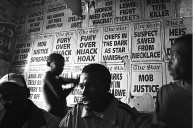There’s nothing cursory or stereotypical about the Brooks Museum’s current exhibition “Snap Judgments: New Positions in Contemporary African Photography.” Internationally respected curator Okwui Enwezor presents a poignant collection of more than 200 artworks (photographs, videos, and multimedia) by 35 African artists who record their continent with pathos tempered by beauty and courage.
Ethiopian photographer Michael Tsegaye’s untitled C-print depicts a slender, middle-aged man dressed in clean denim. He stands in a small room on a stained, pockmarked floor that is swept clean. The man looks grateful, proud of his own space and of his table, pots, dishes, and barrels.
The walls of the room seen in Guy Tillim’s pigment print, Ntokozo and his brother Vusi Tshabalala at Ntokozo’s place, Milton Court, Pritchard Street, are plastered with headlines that read “Teen Killer,” “Mob Justice Spreads,” and “Fury Over Hijack Hoax.” However, there’s nothing brutish or shrill taking place inside Ntokozo’s modest home. Instead, the South African brothers share a moment of camaraderie and reasoned dialogue while the world around them spins out of control.
Because many of the shapes and textures of Africa are unfamiliar, they often look hauntingly abstract. At first glance, Egyptian artist Boubacar Toure Mandemory’s chromomeric print, Couleurs of Peche, looks like calligraphy written across richly textured and pigmented color fields. The work’s English translation, “Colors of Fishing,” invites a closer look at a sleek ebony figure running across blue, yellow, and mauve fishing nets with the grace and athleticism of one who lives close to the land and sea.
Egyptian photographer Hala Elkoussy’s muted colors and impressionist treatment of light suggest eerie dreamscapes. Up close, his inkjet print on vinyl, Peripheral Landscape #1, becomes polluted atmosphere and crumbling concrete tenements on barren ground. There’s no topsoil, no vegetation, no songbird, no habitat. There is only silent witness to the environmental devastation and impoverishment of many African countries.
South African artist Tracey Rose turns religious dogma, gender roles, and racial biases on their heads. In a series of photographs titled Lucie’s Fur, gay Zulu men take on the roles of Adam and Eve, a black woman is the Messiah, and “Lucy,” the ancient hominid for which this series is named, becomes one of God’s messengers.

Featured in the Brooks’ ‘Snap Judgements’: works by Guy Tillim
A mother-earth Madonna rides on a donkey in Rose’s iris print, The Prelude, The Garden Path. Bright red falsies are strapped across her ample bosom; a large phallic-and-scrotum-shaped hat sits on her head. She rides the donkey on bare earth through narrow canyons. It’s a vista that suggests she’s riding into her own womb, into her own sexual power.
Are Rose’s images too raw and sardonic? As we bear witness to countries torn apart by civil war, homeless children, thin as rails, sleeping on concrete, women treated as chattel, and lands and peoples raped by a catastrophic blend of religiosity, imperialism, and testosterone in overdrive, we realize that nothing less than Rose’s savvy, savage irony will do.
At the Brooks Museum through May 25th
Elizabeth Alley’s style is simultaneously lush and existential. She zeroes in on the sharply angled in photographs and crops the heads of any figures in the scenes. She then loads her brushes with oils or acrylics and re-creates the images on canvas.
For “Class of ’88,” the current exhibition at Material, Alley paints the satin midriffs and bare arms of beauty contestants in Junior Miss. From the sepia eyes to the Hershey Bar-brown hair, Alley records a teenager raising her sunglasses and looking up into a blue-gray sky in Sunday’s Best. In Teacher’s Pet she nearly fills the picture plane with the soft red folds of a teacher’s plaid shirt.
Titles such as Catch the Spirit and Million Dollar Band capture the invincibility and exuberance of teenagers who could be from almost any decade, any state, and any public school in the U.S.A.
The cheerleader depicted from the shoulders down in We Are Super, We Are Great, with a crayon in one hand and arms resting on thighs, could be Alley as a teenager leaning forward and contemplating the poster she is about to create.
Looking at this piece 20 (or 30 or 40) years after graduation, one can’t help but think of and rue the expectations that unseen blank paper of We Are Super, We Are Great represents. The work allows us to step back and experience a little swell of exuberance. At this moment, we are super, we are great.
At Material through May 31st